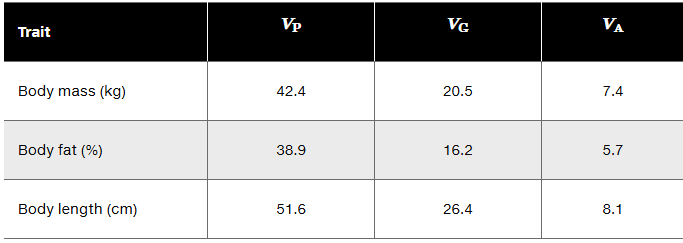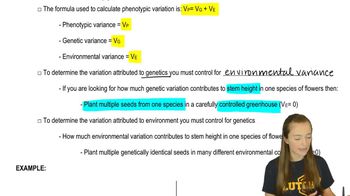In a population of tomato plants, mean fruit weight is 60 g and h² is 0.3. Predict the mean weight of the progeny if tomato plants whose fruit averaged 80 g were selected from the original population and interbred.
Table of contents
- 1. Introduction to Genetics51m
- 2. Mendel's Laws of Inheritance3h 37m
- 3. Extensions to Mendelian Inheritance2h 41m
- 4. Genetic Mapping and Linkage2h 28m
- 5. Genetics of Bacteria and Viruses1h 21m
- 6. Chromosomal Variation1h 48m
- 7. DNA and Chromosome Structure56m
- 8. DNA Replication1h 10m
- 9. Mitosis and Meiosis1h 34m
- 10. Transcription1h 0m
- 11. Translation58m
- 12. Gene Regulation in Prokaryotes1h 19m
- 13. Gene Regulation in Eukaryotes44m
- 14. Genetic Control of Development44m
- 15. Genomes and Genomics1h 50m
- 16. Transposable Elements47m
- 17. Mutation, Repair, and Recombination1h 6m
- 18. Molecular Genetic Tools19m
- 19. Cancer Genetics29m
- 20. Quantitative Genetics1h 26m
- 21. Population Genetics50m
- 22. Evolutionary Genetics29m
20. Quantitative Genetics
Heritability
Problem 23a
Textbook Question
New Zealand lamb breeders measure the following variance values for their herd.

Calculate the broad sense heritability (H²) and the narrow sense heritability (h²) for each trait in this lamb herd.
 Verified step by step guidance
Verified step by step guidance1
Identify the variance components given for each trait: phenotypic variance (VP), genotypic variance (VG), and additive genetic variance (VA).
Recall the formulas for heritability: Broad sense heritability (H²) is calculated as H² = VG / VP, which represents the proportion of phenotypic variance due to all genetic factors.
Narrow sense heritability (h²) is calculated as h² = VA / VP, representing the proportion of phenotypic variance due to additive genetic effects only.
For each trait (Body mass, Body fat, Body length), substitute the given values into the formulas: calculate H² by dividing VG by VP, and calculate h² by dividing VA by VP.
Interpret the heritability values to understand the genetic contribution to each trait's variation, which can inform selective breeding decisions.
 Verified video answer for a similar problem:
Verified video answer for a similar problem:This video solution was recommended by our tutors as helpful for the problem above
Video duration:
4mPlay a video:
Was this helpful?
Key Concepts
Here are the essential concepts you must grasp in order to answer the question correctly.
Phenotypic Variance (VP)
Phenotypic variance represents the total observed variation in a trait within a population, combining both genetic and environmental influences. It is the sum of genetic variance (VG) and environmental variance (VE). Understanding VP is essential because heritability calculations use it as the denominator to express the proportion of variance due to genetics.
Recommended video:
Guided course

Analyzing Trait Variance
Broad Sense Heritability (H²)
Broad sense heritability is the proportion of total phenotypic variance attributable to all genetic variance (VG), including additive, dominance, and epistatic effects. It is calculated as H² = VG / VP. This measure indicates the overall genetic contribution to trait variation but does not distinguish the type of genetic effects.
Recommended video:
Guided course

Calculating Heritability
Narrow Sense Heritability (h²)
Narrow sense heritability quantifies the proportion of phenotypic variance due specifically to additive genetic variance (VA), which is the genetic component passed from parents to offspring. It is calculated as h² = VA / VP and is crucial for predicting response to selection in breeding programs.
Recommended video:
Guided course

Calculating Heritability

 7:04m
7:04mWatch next
Master Calculating Heritability with a bite sized video explanation from Kylia
Start learningRelated Videos
Related Practice
Textbook Question
360
views
